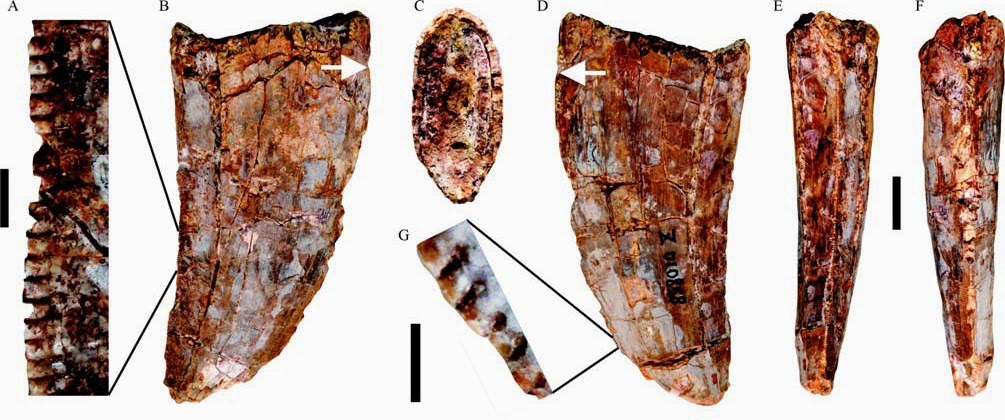The Therizinosauria are a poorly understood group of Theropod
Dinosaurs from the Cretaceous of Asia and North America, exhibiting a number of
unique, and sometimes hard to interpret, features. These include the loss of
the front teeth, leaf-shaped rear teeth, an elongate neck, wide hips and long
arms with feathers and large sickle-shaped claws. It has been widely accepted
that these are adaptations to herbivorey, but the group is not well understood,
as it is known largely from fragmentary skeletons.
In a paper published in the Journal of Vertebrate Paleontology on 4
November 2014, Stephan Lautenschlager of the School of Earth Sciences at the
University of Bristol, Lawrence Witmer of the Department of Biomedical Sciences
at the Heritage College of Osteopathic Medicine at Ohio University, Perle Altangerel
of the National University of Mongolia, Lindsay Zanno of the Nature ResearchCenter at the North Carolina Museum of Natural Sciences and the Department ofBiology at North Carolina State University and Emily Rayfield, also of the School
of Earth Sciences at the University of Bristol present a three-dimensional
reconstruction of the skull of Erlikosaurus andrewsi,
the most complete known Therizinosaur skull specimen.
Digital representation of the skull of Erlikosaurus andrewsi. (A) Left lateral; (B)
dorsal; and (C) ventral views. Abbreviations: bsp, basisphenoid; exoc,
exoccipital; f, frontal; j, jugal; la, lacrimal; mx, maxilla; n, nasal; oc,
occipital condyle; pa, parietal; pal, palatine; pmx, premaxilla;po,
postorbital; prf, prefrontal; pty, pterygoid; q, quadrate; qj, quadratojugal;
soc, supraoccipital; sq, squamosal; vo, vomer. Lautenschlager et al. (2014).
The specimen was discovered at the Upper Cretaceous Baishin Tsav
locality of Mongolia, and previously described in 1980, 1981, 1983 and 1994
when the Therizinosaur were far less well understood as a group, and when
technology such as Computed Tomographic (CT) scanning were unavailable. Lautenschlager et al. subjected the specimen to CT
scanning at XTek Systems Ltd. (now Nikon Metrology) at Tring in Hertfordshire,
England, and in addition scanned two related species, Falcarius utahensis and Nothronychus mckinleyithen
at Ohio University. They then built up a three-dimensional computer model of
the skull.
Restored skull of Erlikosaurus andrewsi.
(A) Left lateral; (B) dorsal; and (C) ventral views. Abbreviations: bsp,
basisphenoid;exoc, exoccipital; f, frontal; j, jugal; la, lacrimal; mx,
maxilla; n, nasal; oc, occipital condyle; pa, parietal; pal, palatine; pmx,
premaxilla; po, postorbital;prf, prefrontal; pty, pterygoid; q, quadrate; qj,
quadratojugal; scr, sclerotic ring; soc, supraoccipital; sq, squamosal; vo,
vomer. Lautenschlager et al. (2014).
From this reconstruction Lautenschlager et al. conclude that Erlikosaurus andrewsi
almost certainly had a keratinous beak over the front part of its snout,
something that has previously been speculated (and in some cases proven) for
other non-avian Theropod Dinosaurs.
Reconstructed rhamphothecae of Erlikosaurus andrewsiwith (A) small and (B) extensive keratinous
sheath (rendered transparentin the back to reveal underlying bone). Lautenschlager et al. (2014).
See also…
Terrestrial faunas of the Triassic comprised a wide variety of large
Vertebrates, including Synapsids and both Dinosaurian and
non-Dinosaurian Archosaurs. At...
In recent years China has become a focus for...
Dinosaurs are the most distinctive element of Mesozoic Vertebrate
faunas, arising in the Triassic, and coming to dominate all known
terrestrial ecosystems during the Jurassic and Cretaceous, before
disappearing abruptly (other than the still extant Birds) at the end of
that period. Despite this widespread distribution, very few...
Follow Sciency Thoughts on Facebook.






